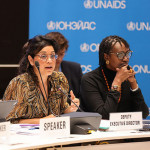As we mark the 35th annual World AIDS Day, commemorated annually on December 1, we find that we have made great strides in the fight to end the global HIV epidemic. However, we still have a long way to go until all countries affected reach levels of HIV diagnoses, treatment and undetectability high enough to essentially halt new infections.
Moreover, although we’ve made tremendous gains in delivering safe, effective and easy-to-take prevention and treatment methods globally, we’re still likely years away from a vaccine and a cure—the two elements that would bring the epidemic to a true end.
Below, POZ talks with Mitchell Warren, executive director of the global HIV prevention advocacy and development group AVAC, about exactly where we are in the fight to end global AIDS, the advances as well as the setbacks (many of them political rather than scientific) that we’ve seen in the past year or so and where we go from here.
Can you tell us the current state of the global fight against HIV and AIDS?

Mitchell WarrenCourtesy of Mitchell Warren
I’d fall back on Dr. Anthony Fauci [who last year retired after nearly 40 years heading the National Institute of Allergy and Infectious Diseases, the U.S. government’s key HIV and AIDS research agency], who in 2020 said that much has been accomplished and yet there’s so much left to do.
I think a lot about the progress we’ve achieved in providing ARVs [antiretroviral medications] worldwide, about what the global HIV response contributed to the COVID-19 response and continues to contribute to current conversations about preparing for future pandemics. It’s remarkable. Even 20 years ago, none of us would’ve said that we’d achieve so much by 2023.
And yet that progress has not been equitable and is not yet sustainable. What we’ve achieved today could slip away so quickly, whether we’re looking at dreadful laws passed recently in Uganda [severely criminalizing homosexuality] or in a number of states domestically [against everything from gender-affirming health care to open discussion or content about LGBTQ issues in schools]. Our progress is fragile.
What percent of the world has HIV treatment?
We have about 40 million people living with HIV worldwide and approximately 25 million are receiving ARVs, which is a huge achievement. In 2000, the percentage of people worldwide on treatment was in the single digits.
At the world AIDS conference that year in Durban, South Africa, not a single person on the African continent was getting treatment. And now, thanks largely to the establishment of the U.S. President’s Emergency Plan for AIDS Relief (PEPFAR) and the Global Fund to Fight AIDS, Tuberculosis and Malaria, the vast majority of those on treatment are in Africa.
Who is not getting treatment?
Whether we’re talking India, Kenya, Peru or the United States, it’s people who are the poorest and most marginalized, those most left behind because of stigma and discrimination, which domestically is Black and brown gay men and transgender women. Many of these folks globally are not in the health system, which means you’re not even going to get an HIV test.
However, there are now at least five countries—Botswana, Eswatini, Tanzania, Rwanda and Zimbabwe—that have achieved “95-95-95,” which means 95% percent of people with HIV know their status, 95% of them are on treatment and 95% of those are virally suppressed, or undetectable.
The United States and South Africa are not among this group. It tends to be countries that have invested not just health resources but political capital into this effort and that have robust human rights protections. The flip side is a country like Uganda with heinous anti-LGBTQ laws that discriminate against and further stigmatize gay and trans people, who then are too afraid to even access the health system.
Also, Eastern Europe is very left behind because their HIV epidemic is driven by injection drug users, who are heavily criminalized and stigmatized there.
The future of PEPFAR, the successful U.S. program that delivers HIV prevention and treatment to poor countries started by President Bush in 2003, is now somewhat in question, with right-wing Republicans in Congress recently blocking the routine five-year reauthorization of the program due to unproven allegations that the program is providing money for abortions overseas. What does that uncertainty mean for PEPFAR?
Just because PEPFAR was recently not reauthorized for another five years doesn’t mean that it’s disappeared—it’s enshrined in law, alive and well and delivering huge impact. But I get nervous without reauthorization, because reauthorization allows you to look years out and think about long-term progress.
Lack of reauthorization allows people to say, “Is there really a future in this work? And how do I plan [in my own country] if PEPFAR, one of the major engines of progress, doesn’t know its future?” That stunts innovation and the ability to plan strategically. It sucks the oxygen out of the room.
Let’s talk about HIV vaccines. We’ve only had epic fails the past many years. Where are we now?
At a place of both enormous scientific opportunity and huge challenge. All the studies done, including those in which the vaccine candidates failed to protect, have led us to know what doesn’t work related to this virus and the immune system.
The Nobel Prize was just won by Katalin Karikó and Drew Weissman for their work on using mRNA as a vector [delivery platform] for vaccines, which they first developed for an HIV vaccine [but ended up using very successfully for COVID vaccines].
But [a vaccine for] COVID is easy compared to HIV, which at every turn has proven to be an even harder virus to make a vaccine for than we ever imagined. A few new approaches are showing promise, but we’re still years away from a vaccine, which could help us ensure a sustainable end to the pandemic.
Can you talk about those new approaches?
There are three. One involves broadly neutralizing antibodies, or bnAbs. Could giving people a direct antibody provide protection? People are taking what we’ve learned about the partial protection that bnAbs give and using the mRNA platform to induce it. There are now three Phase I studies looking at different mRNA for that purpose.
Another involves using cytomegalovirus, or CMV, a very common virus, as a vector. Just last month, the National Institutes of Health (NIH) funded the first human Phase 1 study. It’s already worked well in early animal studies. There are lots of issues around how to make this a safe platform.
And then there’s something called sequential immunization. HIV is constantly changing, which is a challenge for antibodies. So now there’s a Phase I study for sequential immunization, which is vaccinating people with a sequence of slightly tweaked versions of the vaccine to try to get a step or two ahead of the virus. It’s never been done, but the idea is based on really solid data.
What is the real sticking point with HIV vaccines? Why was a COVID vaccine so easy to achieve in comparison?
The COVID virus has a fixed spike protein on it, a kind of lock to the key that immune cells try to turn, and it was clear that if you could get into that protein, you could stop the virus from replicating. But with HIV, the spike protein, or the lock on its surface, is constantly changing, and we don’t have the ultimate key for this ever-changing lock.
In the absence of a vaccine, let’s talk about other preventive measures. What is the state of global delivery of pre-exposure prophylaxis (PrEP), an oral or injectable regimen of HIV medications that prevent the virus?
It’s unfinished business. We now have three different PrEP options—oral pill, a periodic injectable and a ring inserted into the vagina—that have all been proven safe and effective, but they’re not reaching all the people who need them most. We’ve had oral PrEP now for over a decade. And recently, we’re beginning to see access to both injectable PrEP and the vaginal ring in a number of African countries.
Over the next year, we have the opportunity to learn if an increase in choice increases use, as has been the case with contraception. That’s huge and exciting. A challenge is that we don’t have robust prevention platforms worldwide, as we do with treatment, that allow us to quickly switch people from one choice to another.
AVAC’s global PrEPWatch tracker shows that about 4 million people have initiated PrEP in the past decade, but that’s a small number in the context of the need. Still, we’re seeing dramatic increases every quarter from pretty much every country that reports on PrEP.
What can you tell us about the state of cure research?
Finding both a cure and a vaccine is where a lot of science is directed right now. There’s more scientific enthusiasm around a cure now than there’s been for a number of years. The small number of individuals who’ve been cured in recent years, almost all through very invasive bone-marrow transplants they needed to treat their cancer, have generated for us whole new insights into what it might take to search for HIV in these viral reservoirs [where the virus hides in the body] and what a feasible cure strategy might be.
It’s very early science, but funding for it has almost doubled in the past year, from the NIH, the Gates Foundation, the Netherlands—and pharma companies, including Gilead, which has invested a lot of time and resources into the cure agenda. Will this lead to a cure? We don’t know. But there are more pathways right now than we ever imagined.
Can you share some examples that zoom in on what we’ve been talking about?
There are a few exciting things. Recently, in Uganda, The Choice Manifesto was launched by a group of young women throughout eastern and southern Africa. They’re calling for choices in HIV prevention, saying, “This is what we want in our communities.” They successfully lobbied Winnie Byanyima, executive director of the Joint United Nations Programme on HIV/AIDS (UNAIDS), to get behind this.
And more recently, a group of individuals across key populations affected by HIV—transgender women and men who have sex with men—came together to create a road map, a community-led statement saying, “This is what prevention needs to look like for us.”
These two launches say to me that, while scientists, policymakers and funders will continue to drive and be essential to this work, it’s community leadership and mobilization that’ll end this epidemic.
There are so many other things going on in the world right now—climate change, humanitarian disasters, wars, mass migration, increasingly rightward shifts in many governments and societies. How do these affect the fight to end global HIV and AIDS?
No matter how good the science or community leadership, HIV will not end if we don’t have significant policy change to reverse or lessen criminalization and stigmatization of any affected population, such as injection drug users or men who have sex with men.
Whether it’s in Uganda, India or the United States, if we can’t protect human rights, then we can’t end HIV, nor can we end COVID or Ebola. This is never just about HIV—it’s about sex and drugs, behaviors that are the most stigmatized and criminalized.
Uganda’s antigay law has been in play a few months now. Is there evidence it is negatively affecting efforts against HIV?
Absolutely. We just learned this at the International AIDS Society conference in Brisbane, Australia: that LGBTQ Ugandans are not accessing health systems and health providers are censoring their own work because they’re scared. People are falling out of treatment because they don’t want to go for their medication refills.
Laws like this have terrifying public health consequences. Twenty years ago, you’d have said that Uganda was the great success story in the HIV response. But progress can tip back overnight.







Comments
Comments